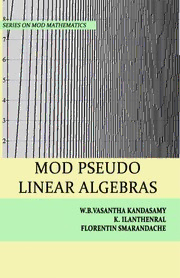
MOD Pseudo Linear Algebras PDF
Preview MOD Pseudo Linear Algebras
Pseudo MOD Linear Algebras W. B. Vasantha Kandasamy Ilanthenral K Florentin Smarandache 2015 This book can be ordered from: EuropaNova ASBL Clos du Parnasse, 3E 1000, Bruxelles Belgium E-mail: [email protected] URL: http://www.europanova.be/ Copyright 2014 by EuropaNova ASBL and the Authors Peer reviewers: Dr. Stefan Vladutescu, University of Craiova, Romania. Dr. Octavian Cira, Aurel Vlaicu University of Arad, Romania. Prof. Gabriel Tica, Bailesti College, Bailesti, Jud. Dolj, Romania. Many books can be downloaded from the following Digital Library of Science: http://www.gallup.unm.edu/eBooks-otherformats.htm ISBN-13: 978-1-59973-369-2 EAN: 9781599733692 Printed in the United States of America 2 CONTENTS Preface 5 Chapter One INTRODUCTION 7 Chapter Two REAL MOD MATRICES AND THEIR PROPERTIES 39 Chapter Three ALGEBRAIC STRUCTURES ON MOD SUBSETS OF MOD PLANES 93 3 Chapter Four MULTIDIMENSIONAL MOD PSEUDO LINEAR ALGEBRAS 209 FURTHER READING 261 INDEX 265 ABOUT THE AUTHORS 269 4 PREFACE In this book authors for the first time elaborately study the notion of MOD vector spaces and MOD pseudo linear algebras. This study is new, innovative and leaves several open conjectures. In the first place as distributive law is not true we can define only MOD pseudo linear algebras. Secondly most of the classical theorems true in case of linear algebras are not true in case of MOD pseudo linear algebras. Finding even eigen values and eigen vectors happens to be a challenging problem. Further the notion of multidimensional MOD pseudo linear algebras are defined using the notion of MOD mixed matrices. These function only under the natural product × as the n usual product × cannot be even defined on these mixed MOD matrices. 5 Several innovative and interesting results are given in this book. Many open problems are proposed. We wish to acknowledge Dr. K Kandasamy for his sustained support and encouragement in the writing of this book. W.B.VASANTHA KANDASAMY ILANTHENRAL K FLORENTIN SMARANDACHE 6 Chapter One INTRODUCTION In this chapter we introduce the notion of MOD interval, MOD plane and MOD transformation. For more about these notions [26-30]. Throughout this book (–∞, ∞) is the real line, Z the ring of m modulo integers m and R the real plane. C the complex plane. (–∞i, ∞i) the imaginary line, R(g) (g2 = 0) the dual number plane, R(h) (h2 = h) the special dual like number plane. R(k); (k2 = –k) the special quasi dual number plane, C(Z ) the finite m complex modulo integer i2 = m – 1. F (–∞g, ∞g), (g2 = 0) the dual number line. (–∞h, ∞h) (h2 = h); the special dual like number line. (–∞k, ∞k) the special quasi dual number line. k2 = –k. 〈R ∪ I〉 is the real neutrosophic plane. (–∞I, ∞I) is the neutrosophic number line. 〈R ∪ I〉 = {a + bI | a, b ∈ R, I2 = I}, R(g) = {a + bg | g2 = 0, a, b ∈ R}, R(h) = {a + bh | h2 = h, a, b ∈ R}, 8 MOD Pseudo Linear Algebras C = {a + bi | a, b ∈ R, i2 = –1} and R(k) = {a + bk | a, b ∈ R, k2 = –k} denotes the neutrosophic plane, dual number plane, special dual like number plane, complex plane and special quasi dual number plane respectively. (–∞, ∞) is the real line, (–∞g, ∞g) = {mg | m ∈ R, g2 = 0}, (–∞I, ∞I) = {mI | m ∈ R, I2 = 0}, (–∞i, ∞i) = {mi | m ∈ R, i2 = –1}, (–∞h, ∞h) = {mh | m ∈ R, h2 = h} and (–∞k, ∞k) = {mk | m ∈ R, k2 = –k2} are the real line, dual line, neutrosophic line, complex number line, special dual like number line and special quasi dual number line respectively. We can now proceed onto define the new notion of MOD transformation. For this to occur we recall the definition of MOD intervals of 6 types and the MOD planes of 6 types [26-30]. Let [0, m); 2 ≤ m < ∞ be the interval. We define this interval as MOD real interval. [0, 7), [0, 12), [0, 148), [0, 19) and so on [0, m); 2 ≤ m < ∞ are defined as MOD real intervals. [0, 1) is defined as the fuzzy MOD interval or MOD fuzzy interval [26-30]. We have infinite number of real MOD intervals but only one MOD fuzzy interval. Introduction 9 [0, 43) is the MOD real interval. [0, m) = {a | a ∈ [0, m), that is a cannot take the value m}. [0, 5) = {a | 0 ≤ a < 5; that is a cannot take the value 5}. [0, 24) = {a | 0 ≤ a < 24; that is a can take 23.99…9 but c annot take a = 24}. The advantage of using MOD real intervals is there exists infinitely many MOD real intervals but however one and only one real interval (–∞, ∞). Next we define the complex interval (–∞i, ∞i). We see we have one and only one complex interval (–∞i, ∞i). However [0, m)i ; 2 ≤ m < ∞ is the MOD complex interval F where i2 = m – 1. F We have infinite number of MOD complex intervals for each of this i2 = m – 1, 2 ≤ m < ∞. F [0, 3)i is the MOD complex interval; i2 = 2 and so on. F F [0, 42)i is the MOD complex interval; i2= 41 and so on. F F [0, 14)i = {ai | i2 = 13; 0 ≤ ai < 14i }. F F F F F [0, 215)i = {ai | 0 ≤ ai < 215i , i2= 24} F F F F F are the MOD complex interval. Next we proceed onto describe MOD neutrosophic intervals (–∞I, ∞I); I2 = I is defined as the neutrosophic interval.
